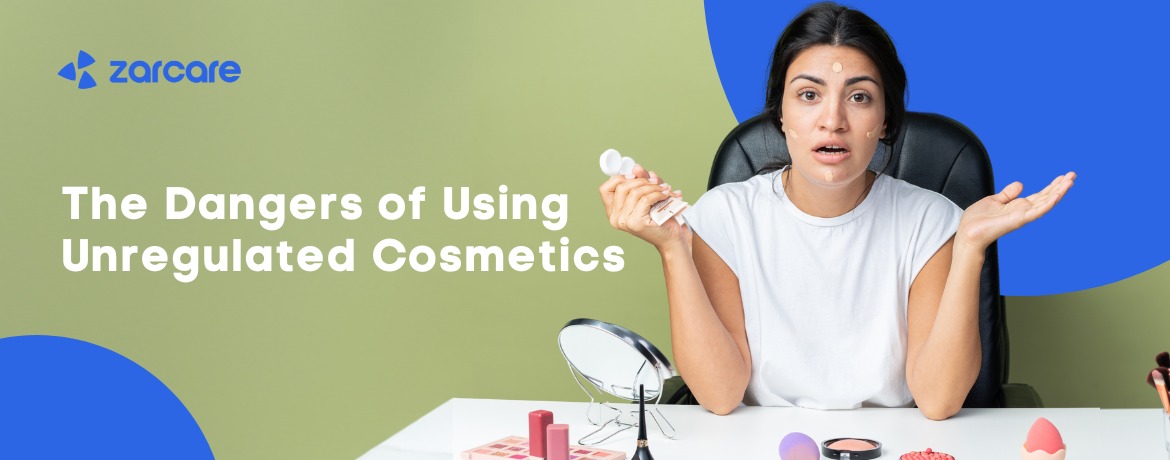The Dangers of Using Unregulated Cosmetics

Cosmetics are products we use daily to enhance our appearance, hygiene, and well-being. But how do we know if they are safe for our health? Unfortunately, the answer is not very reassuring. In the United States, cosmetics and their ingredients are not subject to premarket approval or safety review by the Food and Drug Administration (FDA) unless they are colour additives¹. This means that cosmetic companies are responsible for ensuring the safety of their products before selling them to consumers. Still, they are not required to register their products, list their ingredients, or report any adverse events to the FDA¹. As a result, the cosmetic industry lacks transparency and accountability, and consumers are exposed to potential risks from harmful chemicals, bacteria, and contaminants hiding in their cosmetics. Thousands of chemicals are used in cosmetic formulations, many of which have not been adequately tested for their effects on human health and the environment². Some of the chemicals that have been linked to adverse health outcomes include: – Parabens: These preservatives are widely used in cosmetics to prevent microbial growth and extend shelf life. However, they have been shown to mimic estrogen and disrupt the hormonal system, which may increase the risk of breast cancer, reproductive problems, and developmental disorders²³. – Phthalates: These plasticisers are added to cosmetics to enhance flexibility, durability, and fragrance. However, they have been associated with endocrine disruption, reproductive toxicity, and developmental defects²³. – Per- and poly-fluoroalkyl substances (PFAS): These are synthetic chemicals used in cosmetics to provide water resistance, smoothness, and texture. However, they have been found to persist in the environment and accumulate in the human body, where they can cause various health problems, such as cancer, liver damage, immune dysfunction, and thyroid disruption²⁴. – Heavy metals: These are naturally occurring elements that can be present in cosmetics as impurities or intentional ingredients. However, they can be toxic to the human body, especially when absorbed through the skin and accumulated in the organs. Some of the heavy metals that have been detected in cosmetics include lead, mercury, arsenic, cadmium, and chromium, which can cause neurological damage, kidney failure, skin irritation, and cancer². The best way to protect yourself from the dangers of unregulated cosmetics is to be informed and vigilant about your products. Here are some tips that can help you reduce your exposure to harmful chemicals and contaminants in cosmetics: – Read the labels: Look for the ingredients list and avoid products that contain parabens, phthalates, PFAS, or other chemicals that you are not familiar with. You can also use online databases, such as [EWG’s Skin Deep] or [Think Dirty], to check the safety ratings and reviews of different cosmetic products. – Choose natural or organic products: Opt for natural or organic ingredients that are less likely to contain synthetic chemicals or contaminants. However, not all-natural or organic products are safe or effective, and some may still contain harmful substances. You should always check the labels and research before buying any product. – Buy from reputable sources: Avoid buying cosmetics from unauthorised sellers, such as online platforms, flea markets, or street vendors, which may offer counterfeit or adulterated products that are cheaper but more dangerous. Counterfeit or adulterated cosmetics may contain harmful bacteria, lead, urine, or other substances that can cause infections, allergies, injuries, or intoxication³. Buying cosmetics from authorised retailers like the manufacturer’s website, official stores, or trusted distributors would be best. – Report any problems: If you experience adverse reactions or health issues after using a cosmetic product, you should stop using it immediately and consult a doctor. You should also report the problem to the FDA through their [MedWatch program], which allows consumers to submit voluntary reports of serious adverse events or product quality issues. Your account can help the FDA identify and address any safety concerns with cosmetic products. Cosmetics are an integral part of our daily lives, but they can also pose severe risks to our health if they are not regulated or tested for safety. As consumers, we have the right to know what we are putting on our bodies and are responsible for making informed and safe choices. By reading the labels, choosing natural or organic products, buying from reputable sources, and reporting any problems, we can protect ourselves and others from unregulated cosmetics. (1) Why your cosmetics don’t have to be tested for safety. https://www.pbs.org/newshour/health/why-your-cosmetics-dont-have-to-be-tested-for-safety. (2) Are Harmful Chemicals Hiding in Your Cosmetics? – WebMD. https://www.webmd.com/beauty/features/harmful-chemicals-in-your-cosmetics. (3) Fake Cosmetics and their Health Risks | Department of State. https://dos.ny.gov/fake-cosmetics-and-their-health-risks. (4) Health Dangers of Buying Cosmetics Online. https://www.healthline.com/health-news/health-dangers-buying-cosmetics-online.What are the harmful chemicals in cosmetics?
How can you protect yourself from the dangers of unregulated cosmetics?
Conclusion
